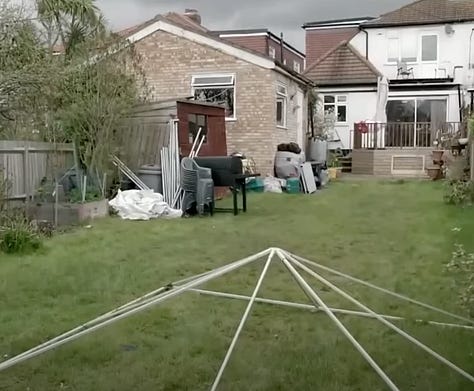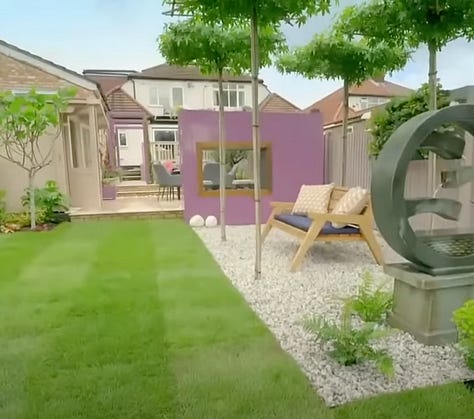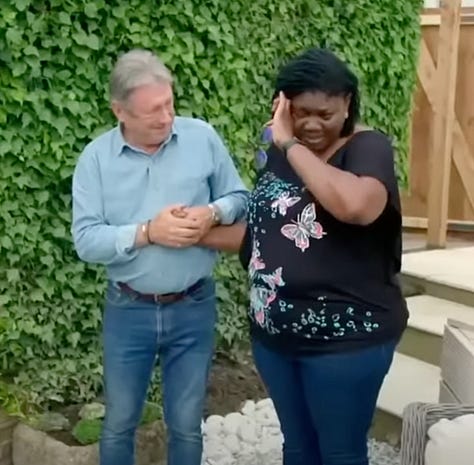Love Your Garden
One day, at our old house two houses ago, we had a chimney fire. Thankfully, four fire departments arrived quickly and contained the damage, but that still left half of the house uninhabitable for a few months. Around the same time, two people, close to the family, died unexpectedly. Because of these events (I believe) I went into something of an “adrenal crisis”, meaning that I started having panic attacks on a regular basis.
I spent a large amount of time on a daybed in the kitchen. My husband took on the greater share of responsibility for our young boys, and our dog did her best to lay with me and provide a weighted blanket with her head. All of these things were very helpful, but it was Alan Titchmarsh who really made the difference.
If you’ve not heard of it, Love Your Garden is a show in the UK, in which a person, or family, who are especially deserving, and/or are undergoing a great hardship, are visited by a team of gardeners and designers (led by Titchmarsh) and, over the course of a few days, come home to find their back yard (“garden” in the UK) transformed into a space specifically suited to their needs. Sometimes I cry a bit at the end, when the people are brought in for the big reveal.



Interestingly, I am basically opposed to the process of Love Your Garden, as it usually involves bulldozing everything and starting from scratch, spending a bizillion dollars on potted plants, trees and shrubs, as well as pre-fab and bespoke structures, patio furniture, outdoor kitchens, etc. BUT for the purpose of what the show is doing (creating instant transformation to serve specific needs) it works. And watching episode-after-episode of (one) people in harder circumstances than mine and (two) a team of problem solvers working together to draft and enact a plan to suit their needs, well - that got me off the couch, eventually.
It also made me start thinking about the many uses to which a “garden” can be put. It can be a gym or a sanctuary or a bar or a kitchen. It can be booming with plants or lack them entirely. In some urban areas, the garden might be a front stoop, and that stoop might be occupied (in fair weather) the bulk of the daylight hours. For someone with acreage, the garden might be a fully functional homestead, with cows and ducks and all. For us, its a yardfarm - my word for everything on our property that is not our house, and for the various purposes those spaces serve.
The Scene at the Roughhousing Yardfarm
I have lived in a variety of homes and apartments - each presenting its own opportunities and limitations for yardfarming. Historically, I have tended to set up systems that are too large for me to maintain, or that are unsuitable for the setting. Optimism, ignorance and a determination to reinvent the wheel have hindered bumper crops and thwarted seedling success. I am very good at creating pollinator gardens, but not deliberately - mostly just because I let the mint run wild.
I have had more success with chickens. I think this is because they are interactive creatures with eyes and beaks and voices, who are capable of yelling for attention, pecking my legs, complaining, cooing with contentment and withholding eggs when I don’t provide them with proper food and water. These birds give me unambiguous feedback, which is to our mutual benefit.
I haven’t yet mastered the language of plants, but I’m working on it.
I am fairly good at learning from my mistakes - though I will often just replace those with new types of mistakes: if I fail at straw bale gardening one year, I will take the opportunity to fail at hugelkultur the next, then maybe try my hand at failing at hydroponics. Now, since I am blogging about such things, I think its time for me to get more methodical.
What I do think I am rather good at is creating an overall system, which takes multiple factors into account. For example: our property is roughly 60x120 feet, which is about a sixth of an acre. Within this space, I wish to:
accommodate a fenced dog yard, just large enough for two dogs to play, but no larger
accommodate a chicken coop and fenced chicken yard, in full view of the kitchen window: the chicken yard should be as large as possible, but not be in the vegetable planting zone.
allow for about 250 square feet of vegetable planting beds, mostly located in the sunniest areas
feature a shed with firewood storage
plus a patio and grassy area, with an exuberant border of flowers, where people might wish to hang out, and perhaps have meals
also, a wood-fired sauna
something to shelter bikes
shelter for garbage cans
a greenhouse
and a little free library in the front yard to encourage conversations from the porch with neighbors
The first four goals have been achieved - though I will be shifting some of the garden beds to a new configuration, and adding a gate from the dog yard to the garden area. When I say “I”, I mean myself and my husband, who I rely upon to do the heavy lifting and assemble the shed kit, etc. He enjoys physical labor and has a greater aptitude than I for doing things the “right way”, which sometimes comes in handy.
How to Go About Creating Your Own Version of the Yardfarm
For fun, you might start by watching an episode or two of Love Your Garden (which you can find on Youtube, and perhaps on Netflix) which might get you thinking about the various uses to which outdoor space may be put. Even if its not your style (typically it isn’t mine), the show is good for inspiring options for outdoor landing places - areas that one might be tempted to inhabit, and thus spend more time in the open air. (I haven’t yet seen them create an outdoor office, but perhaps I might start working on that idea myself…)
After that, I recommend these steps, which I will detail in tomorrow’s Weekend Project article:
size up your resources
determine the footprint of your outdoor space
make a list of purposes that you would like it to serve
hang out and walk around to determine “zones”
mark spaces in the yard with temporary spray paint
set that plan down on graph paper and modify
modify your markings accordingly
prioritize your projects and begin!
Stay tuned for step-by-step instructions.






Thanks Diane! I am very much looking forward to seeing you as well. I love the idea of the perspective shift - I think that the home-processing of as much waste as possible may indeed be the best part of composting. Getting rich soil is the bonus!
I truly look forward to seeing you in May (even though the occasion is such a hard one). I am enjoying your writing “voice” and topics thoroughly. When I listened to your actual voice in your tidying video, I heard Amy so clearly it made me cry. Keep going, Kate. You have a gift for storytelling and practical teaching. We were so far apart in age as children that I hardly felt I knew you but now the gap is small indeed.
Along the line of your gardening journey, I have managed to fail to make good compost for more than 40 years. That is an epic achievement in failure, but still, I have kept tons of garbage out of the landfill and that is an accomplishment I can feel proud of despite the inability to produce brown gold. Sometimes it just takes a perspective shift! 😉